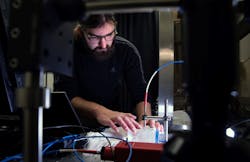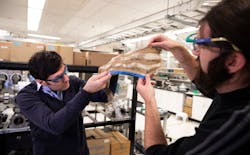A photonic fiber solution to make recycling clothing easier?
Clothing and textiles are notoriously difficult to sort for recycling, but researchers from the University of Michigan and MIT Lincoln Laboratory’s Defense Fabric Discovery Center engineered a clever fix: Woven-in photonic fiber labels that act as “barcodes.” (See video.)
“I’ve been involved in the sustainable materials community for several years and one ‘waste’ stream that typically gets overlooked is textiles,” says Brian Iezzi, a postdoctoral researcher working in Max Shtein’s lab at the University of Michigan (see Fig. 1). “Beyond donating to secondhand stores, most people throw away their used garments. But with rising material costs, and the associated benefits of potentially reusing fibers in new products, there’s an increased focus on methods to recycle textiles.”
Sorting is important in recycling, since the following processes are different depending on composition, and some feedstocks like cotton are more expensive than polyester.
“Large-scale textile sorting facilities have been built in Europe, mainly in Sweden and the Netherlands, that can process up to 24,000 tons/year of textile waste for recycling using the infrared (IR) signature of different fibers,” says Iezzi. “For example, cotton and polyester absorb and reflect IR light differently based on their chemical composition.”
Determining the composition percentage of blended fabrics is challenging. A typical IR spectroscopy system used by sorters today can detect the presence of cotton and polyester, but can’t give an accurate percentage of each.
Sorting systems also have difficulty detecting elastane/spandex, which is increasingly used in “athleisure” apparel, although typically it’s such a small percentage in blended fabrics that it doesn’t show up under near-infrared (near-IR). But its presence in the fabric can make recycling difficult.
“Our idea was to see if we could engineer a photonic fiber with a response in the near-IR that can be read using this same high-throughput sorting equipment—but that will provide a definite answer as to the composition of the fabric via its encoded photonic information,” says Iezzi.
This is an exciting development “because it not only could help make recycling more efficient but, due to the nature of the fabric, also help track textiles throughout the manufacturing supply chain and provide authentication they were made with sustainable materials and using fair labor practices,” Iezzi says. “Both of which are significant challenges within the textile industry today.”
Creating photonic fibers
To create its photonic fibers, the team uses a “structural color” approach: Organizing otherwise transparent materials into stacks of extremely thin layers or microscale patterns can refract and reflect light to achieve a desired optical effect.
“Certain butterflies, such as the morpho, get their color from these structures, and certain types of octopus also use these structures for camouflage, as well as lots of other species,” says Shtein, a University of Michigan professor of materials science and engineering. “We’re using stacks of dozens or even a hundred polymer layers, and can engineer optical ‘overtones’ to further engineer the reflectance peaks. Being able to do this with sufficient fidelity and number of layers in the stack using an all-polymer composition, for example, was a bit of a surprise.”
The structural color in the team’s fiber is derived from a one-dimensional photonic crystal where alternating materials, in this case, two types of polymer—acrylic and polycarbonate—are layered dozens of times.
“Since each layer is on the order of 1 µm thick, incident photons of similar wavelength—in our case, in the visible and near-IR regions—will undergo multiple reflections and refractions, similar to Bragg filters, for example,” says Iezzi. “We produce the fibers by making a preform and then heating it, while mechanically pulling it to create a fiber. It’s similar to how taffy and telecommunications fibers are made.”
The features in the platform are reduced as much as 100-fold in size in the final fiber, creating the micro-/nano-scale photonic stack. “Instead of silica commonly used in telecom fibers, we’re using plastic, which works at much lower temperatures—around 200° to 300°C vs. 1000°C,” Iezzi adds. “A foot-long preform can turn into nearly a mile of fiber.”
What does this mean for photonics? “High fidelity and robust micro- and nano-photonic structures can be difficult to create at scale and economically,” Shtein points out. “We were able to use extremely low-cost, commodity polymers, and a scalable manufacturing process for these photonic fibers—suggesting they can be cost-effective in textile manufacturing. Since these photonic fibers can be interrogated using common light sources and spectrometers, the path to system integration and system-level scalability is much better now than before.”
Challenges and surprises
One of the main challenges the researchers faced was combining the desired photonic and necessary mechanical properties for easy textile integration—weaving, knitting, stitching, etc. Achieving both requirements while making the composition compatible with conventional chemical recycling processes was tricky.
“Most of the work in photonic crystal fibers has focused on using inorganic materials such as high index glasses or a combination of organic (think polymer-based) and inorganic materials,” says Iezzi.
To maximize mechanical flexibility and recyclability simultaneously, they wanted to use only polymers (see Fig. 2). “The challenge here was very low refractive index contrast (delta n is ~0.1) between the layers, whereas more typical combinations—titania and silica—have an index contrast of around 1.0, which requires only a few layers,” Iezzi explains. “We circumvented this constraint by figuring out how to put more than 100 polymeric thin films into our fiber preform to achieve a high signal-to-noise ratio in the response spectrum.”One counterintuitive step the researchers took when creating their barcode was to leverage the tendency of photonic crystals to exhibit “overtone” responses at shorter wavelengths.
“These overtone resonances are typically undesirable in most photonic applications, and a lot of effort goes into engineering them out,” says Iezzi. “We actually use the overtone resonances to create a unique optical signature. With the cost and size of LEDs and spectrometers dropping rapidly, maybe even regular consumers will be able to scan this barcode fiber using their smartphones in the foreseeable future.”
Patent protection/commercialization
The team has applied for patent protection and is currently evaluating ways to commercialize their technology.
“We’re actively pursuing applications,” says Shtein. “Since miles of fiber can be readily made, potential manufacturers can be engaged sooner than later to test using this fiber in their systems—meaning you could see fibers like this in textile products within the next couple of years. A lot will depend on which applications and partnerships emerge first.”
FURTHER READING
B. Iezzi et al., Adv. Mater. Technol. (Feb. 6, 2023); https://doi.org/10.1002/admt.202201099.
About the Author
Sally Cole Johnson
Editor in Chief
Sally Cole Johnson, Laser Focus World’s editor in chief, is a science and technology journalist who specializes in physics and semiconductors.


